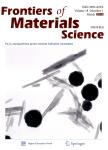Sol-gel synthesis,properties and protein loading/delivery capacity of hollow bioactive glass nanospheres with large hollow cavity and mesoporous shell
作者机构:Glass Research DepartmentNational Research CentreCairo 12622Egypt
出 版 物:《Frontiers of Materials Science》 (材料学前沿(英文版))
年 卷 期:2022年第16卷第3期
页 面:145-157页
核心收录:
学科分类:07[理学] 070205[理学-凝聚态物理] 08[工学] 080501[工学-材料物理与化学] 0805[工学-材料科学与工程(可授工学、理学学位)] 0702[理学-物理学]
主 题:bioactive glass hollow nanosphere hollow cavity mesoporous shell soft-template ultrasound assisted sol-gel synthesis therapeutic protein delivery
摘 要:Hollow nanospheres exhibit unique properties and find a wide interest in several potential applications such as drug ***,novel hollow bioactive glass nanospheres(HBGn)with large hollow cavity and large mesopores in their outer shells were synthesized by a simple and facile one-pot ultrasound assisted sol-gel method using PEG as the core ***,the produced HBGn exhibited large hollow cavity with ~43 nm in diameter and mesoporous shell of ~37 nm in thickness and 7 nm pore size along with nanosphere size around 117 *** confirmed the presence of Si and Ca elements at the surface of the HBGn outer ***,HBGn showed high protein loading capacity(~570 mg of Cyto c per 1 g of HBGn)in addition to controlled protein release over 5 *** also demonstrated a good in vitro capability of releasing calcium(Ca^(2+):170 ppm)and silicate(SiO_(4)^(4-):78 ppm)ions in an aqueous medium over 2 weeks under physiological-like *** in vitro growth of bone-like hydroxyapatite nanocrystals was exhibited by HBGn during the soaking in SBF.A possible underlying mechanism involving the formation of spherical aggregates(coils)of PEG was proposed for the formation process of HBGn.



